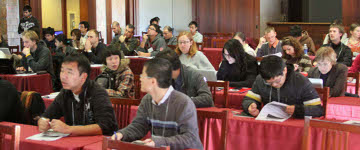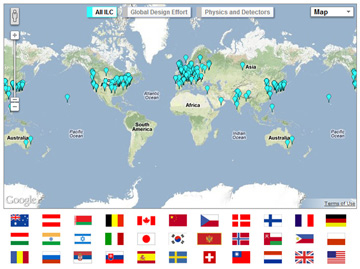FeatureFrom Fermilab Today: Origins of mass: It’s not what you thinkIf you have even the faintest interest in particle physics, you've heard about the Higgs boson. The Higgs boson is the leading candidate explanation for the origin of the masses of point-like subatomic particles. By extension, the Higgs boson is the origin of mass in the universe, right? There's only one problem with that statement—it's totally wrong.
Read the full article in Fermilab Today. View videos about the Higgs boson from the author, Don Lincoln: What is the Higgs Boson? | Higgs Boson: How do you search for it? (and latest news) |
Director's CornerLinear Collider Accelerator SchoolThe Sixth International Accelerator School for Linear Colliders was held from 6 to 17 November at the Asilomar Conference Center in Pacific Grove, California, US. The Global Design Effort has co-sponsored this successful school from inception and we are proud of the fact that many graduates have gone on to careers in accelerator science, including at the ILC.
|
Image of the week
|
Mapping the ILC
The ‘international’ in ‘International Linear Collider’ isn’t just a part of a name. The ILC is demonstrably global, involving thousands of scientists from the Americas, Asia and Europe in accelerator activity, detector research and physics pursuits. The map is a picture of ILC activity around the world.
Visit the map webpage and click around. And if you notice any inaccuracies or see that an institution is missing, please don’t hesitate to notify us. We can make corrections. Enjoy exploring the world of the ILC! |
In the News
-
from NHK News18 January 2012GDE director visits ILC candidate site in Northern Japan. (in Japanese)
-
from Southeast European Times17 January 2012Serbia’s scientific community received a boost this month as the country became an associate member of the European Organization for Nuclear Research (CERN).
-
from DESY13 January 2012For the first time, the researchers have managed to employ a special form of magnetism for data storage purposes, called antiferromagnetism. Different from ferromagnetism, which is used in conventional hard drives, the spins of neighbouring atoms within antiferromagnetic material are oppositely aligned, rendering the material magnetically neutral on a bulk level. This means that antiferromagnetic atom rows can be spaced much more closely without magnetically interfering with each other. Thus, the scientist managed to pack bits only one nanometre apart.
-
from CNRS/IN2P312 January 2012GUINEVERE is a reactor entirely composed of nuclear fuel, lead and a particle accelerator that controls the reactor. It is a demonstration model of an ADS (Accelerator Driven System).
-
from BBC News6 January 2012Another grant will go to Trinity Catholic School in Nottingham, where pupils will build their own atom smasher. They will construct a model linear particle accelerator and investigate particle collisions similar to those under way at the Large Hadron Collider at Cern in Switzerland.
Copyright © 2024 ILC International Development Team




